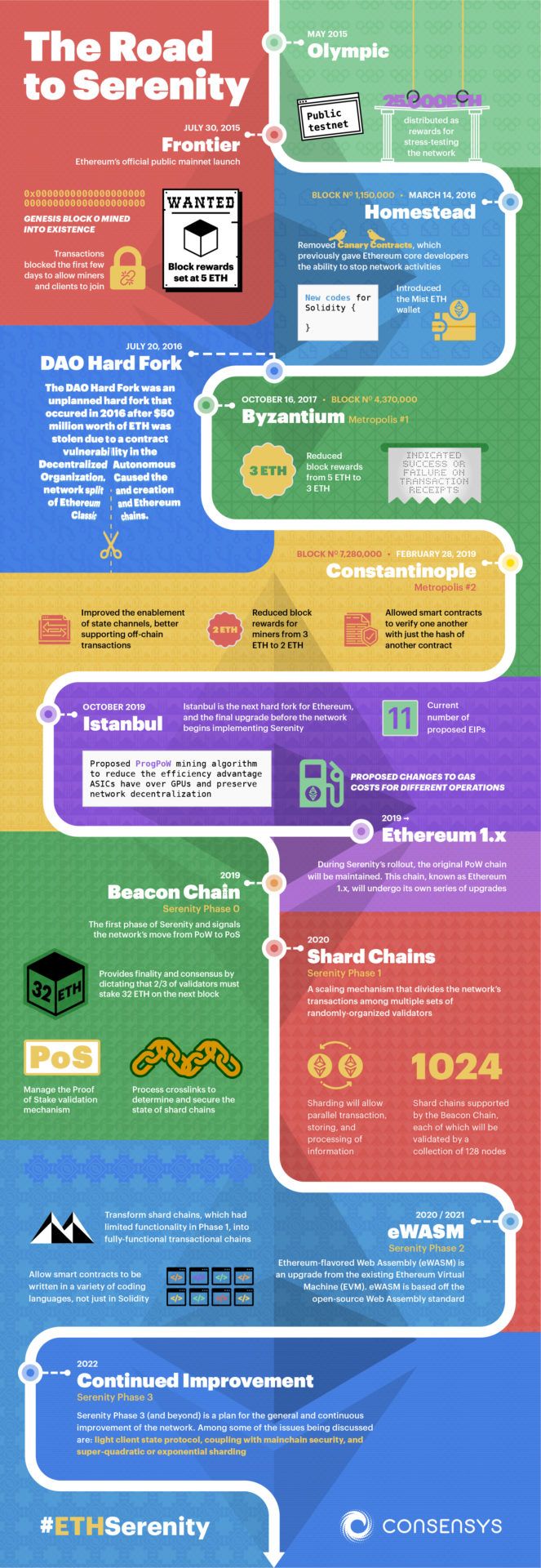We have already written about the Ethereum network in part 1 of our “How Do Cryptocurrencies Differ From One Another” blog post.
In today’s blog, we talk about Ethereum 2.0 that is expected to be launched by the end of this year.
Ethereum 2.0. Is an upgrade to the Ethereum Network. It improves overall performance and scalability. That means that it will be possible to make more transactions and to reduce congestion and high transaction costs on the network. It is meant to become more transparent and enable an open network for decentralized finance (DeFi) and applications.
IntroCheck out this infographic of the Ethereum roadmap to get an overview of the history and future of the Ethereum blockchain. Note that the infographic shows the proposed timeline from 2019. Serenity update has not started yet.

Ethreum 2.0. will include sharding to increase network bandwidth and decrease gas costs. Sending Ethereum and tokens, as well as interacting with smart contracts will become cheaper. There will also be significant economic changes as ETH 2.0 will allow support to staking nodes.
The Three Phases
ETH 2.0 upgrade will be done in 3 phases.
Phase 0 was originally meant to launch at the beginning of 2020, but the release of the mainnet has been pushed back a few times since then. Changes to the network’s technical design that needed attention right before the launch are the reasons why it was pushed back, as well as the need to perform stress tests.
The next plan was to launch on the fifth anniversary of Ethereum in June, but that didn’t work out either.
Phase 0 is now scheduled to happen at some point in late 2020. This will enable the Proof-of-Stake consensus mechanism to be activated beside Proof-of-Work, preventing any confusion when the transition takes place. This is known as the Beacon Chain, however, in the early stages of ETH 2.0, mining will continue as usual.
We might need to wait for the year 2021 before Phase 1 will make its debut. Shard chains will be activated in this phase. To put it simply, ConsenSys correlates this process to splitting the Ethereum 2.0 network into 64 chains and increasing capacity drastically along the way.
Phase 2 is not expected to come until 2022, where transfers and withdrawals, cross-shard transfers, and the capability to build applications are expected to be unlocked.
Eventually, ETH 2.0. will absorb Eth 1.0, which means Proof-of-Work will be retired forever. This is one of the big differences that we will be able to see with the release of ETH 2.0. As mentioned before, mining will continue as usual in the early stage, however, it will be a thing of the past when the focus shifts to staking.
What does the update bring?
The serenity update is going to affect the Ethereum network in two major directions:
- Changed consensus mechanism of the Ethereum blockchain from the Proof of Work (PoW) protocol to Proof of Stake (PoS).
- Improved transaction speeds, volumes, and network scalability through a shard chains solution
PoW is replaced by PoS consensus
The consensus mechanism that Bitcoin uses is PoW protocol. It relies on computers that can churn through an ungodly amount of data at every moment, basically brute-forcing complex computational puzzles. Such Application-specific Integrated Circuit miners (ASIC) are costly, they consume a lot of electricity and they generate quite a lot of heat.
They also quickly become outdated since more capable and newer ASICs appear all the time.
PoS on the other hand, uses virtual miners that are called validators and not physical devices as PoW. Those validators deposit ETH as their stake in the network. They can earn crypto rewards for their participation in the ecosystem. PoS is therefore more energy efficient and better-scalable than a network that is based on PoW.
Shard chains
Since demand continues to increase, the emphasis on scalability will be critical for ensuring the network is prepared for the future. This is accomplished through shard chains, that allow transactions to be processed simultaneously instead of consecutively.
A blockchain as we know processes transaction after transaction, so throughput is limited. Shard chains, however, split the Ethereum blockchain into several sub-chains, which means that Ethereum will become multiple blockchains that are running parallel. Shard chains are an essential part of rising the number of transactions Ethereum can handle per second.
An explanation of the blockchain technology company ConsenSys was:
“Each shard chain is like adding another lane to upgrade Ethereum from a single lane road to a multiple lane highway. More lanes and parallel processing lead to much higher throughput.”
Security, energy efficiency, strong boosting capacity
The transaction validations on this blockchain will not be contingent on computing power anymore and advocates think that the upgrade will make Ethereum 2.0 far more secure, ultimately.
And as mentioned before, it will bring a sizable improvement in energy efficiency, since there are some concerns about the BTC network consuming large amounts of energy.
Strong boosting capacity is also an expectation of Ethereum 2.0, which means that it can manage more transactions per second.
Ethereum 2.0 is the second iteration of this blockchain. It’s crucial that the rollout goes easily, since the way it is bound to the world’s second-largest cryptocurrency by market cap.
Conclusion
It will be intriguing to see how the supply of ETH will change when Ethereum 2.0. Is launched.
There is no limit on the number of Ether that can be in circulation at one time, unlike e.g. Bitcoin, which is limited to 21 million. Some believe that much less ETH will be issued annually once the new blockchain is live.
Sharding and Proof of Stake will bring substantial improvements to security, accessibility, and scalability. ETH 2.0. provides a new opportunity to engage and to be rewarded for maintaining the network.